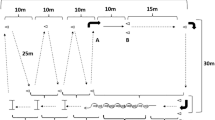Abstract
In order to validate the use of heart rate (HR) in describing and monitoring physiological demands during soccer activities, the HR versus oxygen uptake (V̇O2) relationship determined on the field during soccer-specific exercises was compared to that found in the laboratory during treadmill exercise. Seven male amateur soccer players [mean (SE), age 25.3 (1.2) years, body mass 72.9 (2.1) kg, stature 1.76 (0.03) m] performed three trials on the field (two laps of a purpose-made circuit including a variety of soccer activities) at different intensities (moderate, high and very high, according to their rate of perceived exertion) and an incremental test on a treadmill in the laboratory. HR increased linearly with V̇O2 during both field and laboratory tests according to exercise intensity (P<0.01). The mean correlation coefficients of the HR–V̇O2 relationships obtained in the laboratory and on the field were 0.984 (0.012) and 0.991 (0.005) (P<0.001), respectively. The mean value of the HR–V̇O2 regression equation slope and intercept obtained in laboratory [0.030 (0.002) and 79.6 (4.6), respectively] were not significantly different compared to those found on the field [0.032 (0.003) and 76.7 (9.7)]. The present study seems to confirm that HR measured during soccer exercises effectively reflects the metabolic expenditure of this activity. Thus, with the aid of laboratory reference tests, the physiological demands of soccer activities can be correctly estimated from HR measured on the field in amateur soccer players.





Similar content being viewed by others
References
Ali A, Farrally M (1991) Recording soccer players’ heart rates during matches. J Sports Sci 9:183–189
Astrand PO, Rodahl K (eds) (1977) Textbook of work physiology. McGraw-Hill, New York
Bangsbo J (1994a) Energy demands in competitive soccer. J Sports Sci 12[Spec No.]:S5–12
Bangsbo J (1994b) The physiology of soccer—with special reference to intense intermittent exercise. Acta Physiol Scand 619[Suppl]:1–155
Drust B, Reilly T, Cable NT (2000) Physiological responses to laboratory-based soccer-specific intermittent and continuous exercise. J Sports Sci 18:885–892
Duncan GE, Howley ET, Johnson BN (1997) Applicability of V̇O2max criteria: discontinuous versus continuous protocols. Med Sci Sports Exerc 29:273–278
Ekblom B (1986) Applied physiology of soccer. Sports Med 3:50–60
Ekblom B (1998) A field test for soccer players. Sci Football 1:13–15
Felci U, De Vito G, Macaluso A, Marchettoni P, Sproviero E (1995) Functional evaluation of soccer players during childhood. Med Sport (Roma) 48:221–235
Hoff J, Wisloff U, Engen LC, Kemi OJ, Helgerud J (2002) Soccer specific aerobic endurance training. Br J Sports Med 36:218–221
Kawakami Y, Nozaki D, Matsuo A, Fukunaga T (1992) Reliability of measurement of oxygen uptake by a portable telemetric system. Eur J Appl Physiol 65:409–414
MacLaren D, Davids K, Isokawa M (1988) Physiological strain in a 4-a-side soccer. In: Reilly T, Lees A, Davids K, Murphy WJ (eds) Science and football. Spon, London, pp 76–80
Ogushi T, Ohashi J, Nagahama H, Isokawa M, Suzuki S (1993) Work intensity during soccer match-play (a case study). In: Reilly T, Clarys J, Stribbe A (eds) Science and football. Spon, London, pp 121–123
Reilly T (1997) Energetics of high-intensity exercise (soccer) with particular reference to fatigue. J Sports Sci 15:257–263
Rohde HC, Espersen T (1988) Work intensity during soccer training and match-play. In: Reilly T, Lees A, Davids K, Murphy WJ (eds) Science and football. Spon, London, pp 68–75
Swain DP, Leutholtz BC (1997) Heart rate reserve is equivalent to %V̇O2 reserve, not to %V̇O2max. Med Sci Sports Exerc 29:410–414
Tumilty D (1993) Physiological characteristics of elite soccer players. Sports Med 16:80–96
Van Gool D, Van Gerven D, Boutmans J (1988) The physiological load imposed on soccer players during real match-play. In: Reilly T, Lees A, Davids K, Murphy WJ (eds) Science and football. Spon, London, pp 51–59
Acknowledgements
The authors wish to acknowledge Emiliano C’è and Marcello Iaia for their technical assistance in data collection during the experiments. We also thank the soccer players involved in this study for their committed participation.
Author information
Authors and Affiliations
Corresponding author
Rights and permissions
About this article
Cite this article
Esposito, F., Impellizzeri, F.M., Margonato, V. et al. Validity of heart rate as an indicator of aerobic demand during soccer activities in amateur soccer players. Eur J Appl Physiol 93, 167–172 (2004). https://doi.org/10.1007/s00421-004-1192-4
Accepted:
Published:
Issue Date:
DOI: https://doi.org/10.1007/s00421-004-1192-4




